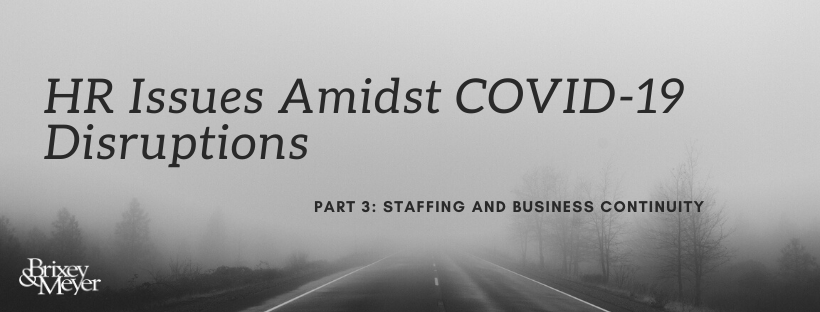HR Issues Amidst COVID-19 Disruptions PART 3: Staffing and Business Continuity
.png?width=820&name=HR%20and%20COVID-19%20(2).png)
Projects/orders cancelled or delayed. Cash flow issues. Over-staffed departments. These are common problems many business face today due to the COVID-19 pandemic. Many options exist to “right-size” a business, but the chosen path should fit within a business’ long-term objectives. This pandemic will pass. Business will resume to a new normal. However, tough decisions must be made now regarding what to do when there is little to no work to be done.
Here are some options businesses should consider:
1. Voluntary Reduction in Hours and/or Pay
This occurs when an employer allows employees to self-select the reduction of their hours worked. This strategy is an aversion to layoffs as the company saves money, yet employees keep their jobs. Although painful, most people prefer this option as oppose to being laid off. There is the potential for employees to lose insurance coverage and other benefits, so it is vital to clearly communicate what happens when/if an employee dips below a certain number of average hours worked. Also, consideration must be given to exempt employees so that they do not drop below the “dollars” test. Under the Fair Labor Standards Act (FLSA), exempt employees must make no less than $684 per week. The focus with this strategy is to ask employees if they want to reduce hours and/or pay. Many times, several employees will choose this option.
2. Mandatory Reduction in Hours and/or Pay
Unlike a voluntary reduction in hours and/or pay, a mandatory reduction is implemented across a division of a business or the business at-large. Again, this strategy is an aversion to layoffs. Legal rules apply based upon whether an employee is hourly (non-exempt) or salaried (exempt). For hourly (non-exempt) employees, a reduction in hours is legally allowed. Depending upon the state of residence, employees may be able to collect partial unemployment benefits. Pay can also be reduced for this group of employees as long as it does not go below minimum wage. For salaried (exempt) employees, the FLSA “dollars” test may result in the exemption being lost. Salaried (exempt) employees can have their hours reduced and their pay not reduced, but this makes no business sense!
3. Furloughs
Although like layoffs, the intent of a furlough is to retain employees long-term. The goal is to have an employee, group of employees, or all employees to stop working for a defined duration of time. With most employees sharing the hardship, this avoids or mitigates layoffs. Often, furloughs last anywhere from a week to several months. The employee stays on the payroll and is still an employee. That person will forgo being paid, though, for a given amount of time. Some businesses plan when groups of employees are furloughed in order to keep a business operating but at a reduced level of production. During a furlough, insurance coverage and other benefits are often retained (in accordance with legal and plan guidelines). Business leaders must be careful of furloughing salaried (exempt) employees for partial days or weeks as they risk losing their exempt status. Furloughed employees often share similar rights to a laid off employee. Rights to unemployment often exist depending upon state law.
4. Layoffs
Unlike a furlough, a layoff is an involuntary separation from a company. This may be due to an operational or budgetary downturn. Employers may use this strategy when uncertainty exists whether business conditions will improve. Put simply, the business cannot afford to pay the employee or group of employees. They may not have a time period in view when conditions will improve, so it does not make sense to enact a furlough. An employer may intend to bring the person back once business conditions improve, but there is a need to end the employment relationship. With a layoff, there is an intent to have this position in the future with out without the laid off employee. In most cases, laid off employees become eligible for unemployment benefits and insurance coverage through COBRA (if applicable).
5. Reduction in Force (RIF)
RIFs, on the other hand, are more permanent in nature. An employee’s position is no longer needed and there is no intent that it will be refilled. The intent to rehire that person is almost non-existent. This could be due to a change in business strategy, major technological improvement, or budgetary reforms. When a situation arises that cannot be solved with temporary solutions (e.g.—furloughs, layoffs), a reduction in force is in order.
Options exist to right-size an organization. All of them are difficult to determine and implement. However, with proper planning, communication, and execution, solid business decisions can be made and people can be treated with respect, dignity, and care.
Over the next several blog posts, I will explore other areas businesses need to consider as they deal with the current COVID-19 disruption. If you missed part one or part two of this multi-part series, please explore them.
Hang in there! This will pass! We are in this together!
Need assistance with addressing short and long term HR needs for your business? Contact me at steve.black@brixeyandmeyer.com, and we will address them proactively.
Disclaimer: This blog is not legal advice, but merely informed opinion or general information meant for no particular purpose. Issues addressed in this blog often implicate federal, state, and local labor and employment laws. This blog is not intended as a substitute for legal advice. Readers should consult labor and employment counsel to determine whether their particular policies, procedures, decisions, or courses of action comply with such laws.

